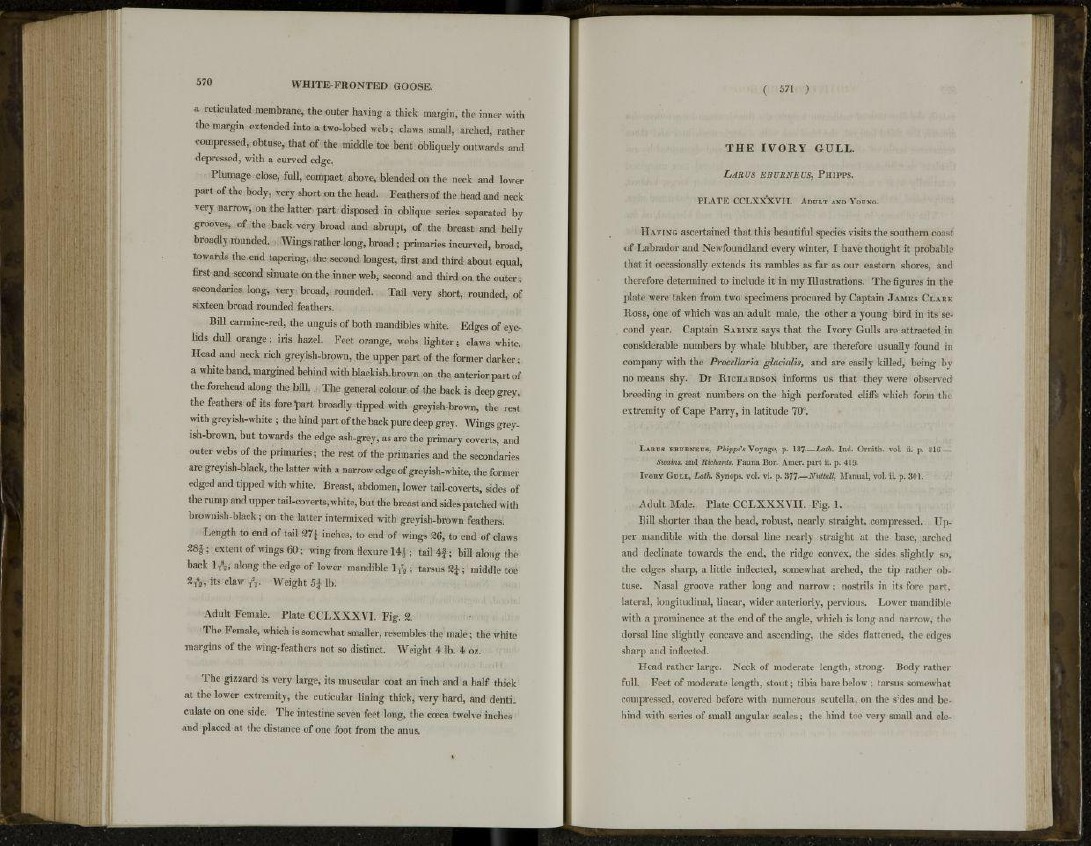
570 WHITE-FRONTED GOOSE.
a reticulated membrane, the outer having a thick margin, the inner with
the margin extended into a two-lobed web; claws small, arched, rather
compressed, obtuse, that of the middle toe bent obliquely outwards and
depressed, with a curved edge.
Plumage close, full, compact above, blended on the neck and lower
part of the body, very short on the head. Feathers of the head and neck
very narrow, on the latter part disposed in oblique series separated by
grooves, of the back very broad and abrupt, of the breast and belly
broadly rounded. Wings rather long, broad ; primaries incurved, broad,
towards the end tapering, the second longest, first and third about equal,
first and second sinuate on the inner web, second and third on the outer;
secondaries long, very broad, rounded. Tail very short, rounded, of
sixteen broad rounded feathers.
Bill carmine-red, the unguis of both mandibles white. Edges of eyelids
dull orange ; iris hazel. Feet orange, webs lighter; claws white.
Head and neck rich greyish-brown, the upper part of the former darker;
a white band, margined behind with blackish-brown on the anterior part of
the forehead along the bill. The general colour of the back is deep grey,
the feathers of its fore part broadly tipped with greyish-brown, the rest
with greyish-white ; the hind part of the back pure deep grey. Wings greyish
brown, but towards the edge ash-grey, as are the primary coverts, and
outer webs of the primaries; the rest of the primaries and the secondaries
are greyish-black, the latter with a narrow edge of greyish-white, the former
edged and tipped with white. Breast, abdomen, lower tail-coverts, sides of
the rump and upper tail-coverts, white, but the breast and sides patched with
brownish-black; on the latter intermixed with greyish-brown feathers.
Length to end of tail 21 \ inches, to end of wings 26, to end of claws
28f; extent of wings 60; wing from flexure 14^ ; tail 4f; bill along the
back l8g, along the edge of lower mandible 17
2 ; tarsus 2% ; middle toe
T
T
2{%, its claw ,5
2 . Weight 5£ lb.
Adult Female. Plate CCLXXXVI. Fig. 2.
The Female, which is somewhat smaller, resembles the male; the white
margins of the wing-feathers not so distinct. Weight 4 lb. 4 oz.
The gizzard is very large, its muscular coat an inch and a half thick
at the lower extremity, the cuticular lining thick, very hard, and denticulate
on one side. The intestine seven feet long, the coeca twelve inches
and placed at the distance of one foot from the anus.
( 571 )
THE IVORY GULL.
LARUS EBURNEUS, PHIPPS.
PLATE CCLXXXVII. ADULT AND YOUNG.
HAVING ascertained that this beautiful species visits the southern coast
of Labrador and Newfoundland every winter, I have thought it probable
that it occasionally extends its rambles as far as our eastern shores, and
therefore determined to include it in my Illustrations. The figures in the
plate were taken from two specimens procured by Captain JAMES CLARK
Ross, one of which was an adult male, the other a young bird in its second
year. Captain SABINE says that the Ivory Gulls are attracted in
considerable numbers by whale blubber, are therefore usually found in
company with the Procellaria glacialis, and are easily killed, being by
no means shy. Dr RICHARDSON informs us that they were observed
breeding in great numbers on the high perforated cliffs which form the
extremity of Cape Parry, in latitude 70°.
LARUS EBURNEUS, Phipps1 S Voyage, p. 187—Lath. Ind. Ornith. vol. ii. p. 810 —
Swains, and Richards. Fauna Bor. Amer. part ii. p. 419.
IVORY GULL, Lath. Synops. vol. vi. p. 377—NtUtatt, Manual, vol. ii. p. 301.
Adult Male. Plate CCLXXXVII. Fig. 1.
Bill shorter than the head, robust, nearly straight, compressed. Upper
mandible with the dorsal line nearly straight at the base, arched
and decimate towards the end, the ridge convex, the sides slightly so,
the edges sharp, a little inflected, somewhat arched, the tip rather obtuse.
Nasal groove rather long and narrow; nostrils in its fore part,
lateral, longitudinal, linear, wider anteriorly, pervious. Lower mandible
with a prominence at the end of the angle, which is long and narrow, the
dorsal line slightly concave and ascending, the sides flattened, the edges
sharp and inflected.
Head rather large. Neck of moderate length, strong. Body rather
full. Feet of moderate length, stout; tibia bare below ; tarsus somewhat
compressed, covered before with numerous scutella, on the sides and behind
with series of small angular scales; the hind toe very small and ele